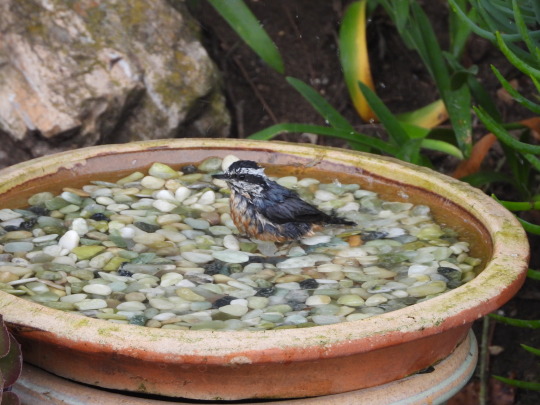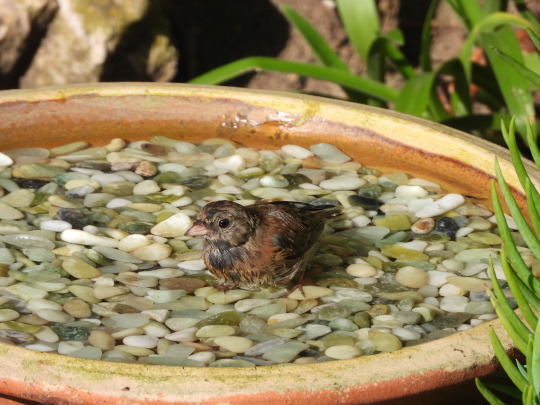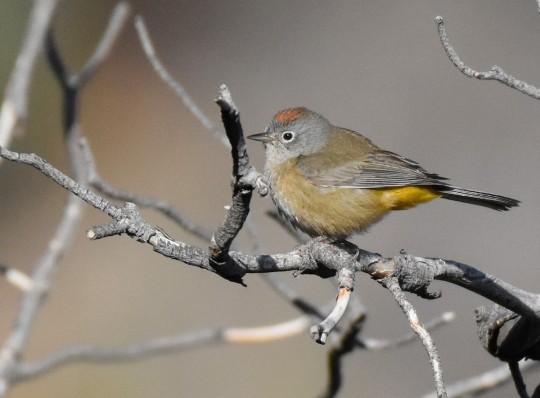#orange crowned warbler
Explore tagged Tumblr posts
Text


Orange-crowned Warbler Brooklyn Bridge Park, Pier 6
#birds#birding#urban birding#nuts_about_birds#birdstagram#patch birding#nature blogger#nyc nature#brooklyn#brooklyn bridge park#bird photography#nyc#nature#migration#warbler#orange crowned warbler
150 notes
·
View notes
Text

Orange-crowned Warbler (Leiothlypis celata)
March 1, 2024
John Heinz National Wildlife Refuge, Tinicum, Pennsylvania
This is usually a rare spring or fall migrant in my part of the country, and this particular bird should be wintering somewhere warm, like Mexico or Florida. Instead, it decided to spend the entire winter in this wildlife refuge next to Philadelphia International Airport. This was the second time I saw it, and there are many other records over the past few months. The orange crown is hidden, and is only visible when the bird is agitated.
#birds#bird#photographers on tumblr#orange crowned warbler#Leiothlypis celata#birdblr#birb#birbs#ornithology#birblr#nature#animals#wildlife photography#warblers#perfectly posed photo of a rare warbler#reference to this:#https://www.tumblr.com/occasionallybirds/705160483187163136/occasionallybirds-be-careful-its-slippery-out
152 notes
·
View notes
Text

orange-crowned warbler

common yellowthroat
yellow birdies ( ˙꒳˙ )
74 notes
·
View notes
Text

Orange-crowned Warbler Leiothylpis celata
12/12/2023 Orange County, California
#orange crowned warbler#warbler#warblers#passerines#parulidae#my photos#bird#birds#nature photography#wildlife#nature#bird photography#wildlife photography#birding#birdwatching
18 notes
·
View notes
Text

Orange-crowned warb, I think!
#birds#nature#nature photography#vancouver island#pnw#birding#bird photography#birdwatching#queue#original photography on tumblr#orange crowned warbler
30 notes
·
View notes
Text



Orange-crowned Warbler (Leiothlypis celata)
Chadron State Park; Fall 2022
Sometimes birds are born with deformities, and sometimes an injury causes them. In the case of this "cross-bill" OCWA, I don't know what the cause was. That being said, the bird's bill is still being worn down cleanly as no overgrowth is present on either side, and it had made at least the first portion of its journey safely- Orange-crowned don't breed in Nebraska, so it's not like this bird hopped out of a nest and into my net. From what I remember, it also had a decent amount of fat present, which bodes well for migration. I hope the lil guy is still doing well out there.
All banding, marking, and sampling is being conducted under a federally authorized Bird Banding Permit issued by the U.S. Geological Survey's BBL. Permission to share images was granted by Bird Conservancy of the Rockies (BCR).
50 notes
·
View notes
Photo

Orange Crowned Warbler
My Card where you can find my socials, where to buy my merch, and commission information, and places to support me like ko-fi https://blackmoonrose13.carrd.co/ https://ko-fi.com/blackmoonrose13 Speed Paint https://youtube.com/shorts/b0nED2cz0dM Reference photo https://bsky.app/profile/ok2panic.bsky.social/post/3lhkevrdius2b Little guy looks adorable, I don't know why I am imaging the little guy just scooting down the branch. I doubt they do that but whimsy you know.
3 notes
·
View notes
Text
Going to do a poll for funsies
#Carolina chickadee#chickadee#tufted titmouse#titmouse#downy woodpecker#woodpecker#yellow rumped warbler#orange crowned warbler#Pine warbler#warblers#ruby crowned kinglet#golden crowned kinglet#kinglet#white breasted nuthatch#brown headed nuthatch#Nuthatch#brown creeper#blue headed vireo#vireo#birds#birdlr#birblr#Polls#flocks#bird poll#Bird#birbs of tumblr#birds of tumblr#southeast us
3 notes
·
View notes
Text

Orange-crowned Warbler
8 notes
·
View notes
Text





backyard pics, put up a birdbath and they love it :)
1 note
·
View note
Text
Week 10 Observations
3.5.25

Camphor Daisy
(Rayjacksonia phyllocephala)
It is a native annual herb in the sunflower family.
It has a camphor scent when the leaves #are crushed and the plant is used by many different pollinators.
Medically it has been used to treat ailments such as heat rash and burns to name a couple.
#camphordaisy #rayjacksoniaphyllocephala #citizenscience #beach #daisy #native #flora #nature #outdoors #march #march5 #2025 #picoftheday #project365 #day64
3.6.25

Buzzer Midge
Chironomus plumosus
Observed on my car at home 3.6.25.
Can be pests when swarming but larvae are a source of food for fish.
It’s in the same family as mosquitos and is a non biting midge.
This one is a male, the females have sleek and not fuzzy antennae.
In spring and summer, males form a mating swarms and females lay their eggs in water. The eggs sink to the bottom where the larvae stay in their silk tubes til they hatch.
#buzzermidge #Chironomusplumosus #citizenscience #insect #nature #outdoors #march #march6 #2025 #picoftheday #project365 #day65
3.7.25

Red Headed Brown Anole
Anolis sagrei, red morph
Observed at home 3.7.25.
They are invasive, mostly coming here in potted plants. They will outcompete green anoles for resources.
They can change there skin color to match their surroundings. The brown anole has a few color variations including red headed.
They are social lizards with male and female territories that can overlap but are kept separate.
They can detach their tails when threatened and are also venomous though their venom is generally harmless to humans.
A female can lay 1-2 eggs every week and once the egg hatches that baby is completely independent.
I believe this one to be a female due to the pattern on its back.
#redheadedbrownanole #anolissagrei #citizenscience #anole #lizard #reptile #introduced #invasive #nature #outdoors #march #march7 #2025 #picoftheday #project365 #day66
3.8.25

Green Anole
Anolis carolinensis
Observed at Galveston Island State Park on 3.8.25.
They are native to southeastern US from Texas to Florida and up to North Carolina. They are more abundant along the Gulf of Mexico and Atlantic coasts.
They can change their skin color to match their surroundings.
Males have a pink dewlap that they can display to attract females or defend territories.
Without enough tree coverage they could become locally extinct and they have to compete for resources with the invasive Cuban Brown Anole.
#greenanole #Anoliscarolinensis #citizenscience #anole #lizard #native #reptile #outdoors #nature #march #march8 #2025 #picoftheday #project365 #day67
3.9.25

Warty Sea Anemone
Bunodosoma cavernatum
I was beyond thrilled that I was able to observe so many anemones off the west end of the sea wall in Galveston 3.9.25.
Its range extends from North Carolina to the West Indies and you can find them in the lower part of the intertidal zone. They attach themselves to hard surfaces such as rocks, jetties, and even shells or they can bury themselves in the sand. They can also crawl though often times remain stationary.
They are nocturnal, spreading their sticky tentacles out to feed on little invertebrates and fish that come into contact with its tentacles. During the day they contract into gelatinous blobs.
They have lobular projections at their base that have stinging cells to protect themselves. These are called acrorhagi.
#wartyseaanemone #bunodosomacavernatum#citizenscience #seaanemone #invertebrates #native #nature #outdoors #march #march9 #2025 #picoftheday #project365 #day68
3.10.25

Orange-crowned Warbler
Leiothlypis celata
Observed 3.9.25 at Galveston Island State Park.
This species of warbler does not typically nest and breed in Texas though can be found year round due to migration or winter birds.
Despite its name you may never see the orange crown unless you spot an excited male flashing its crown.
They eat insects, spiders, seeds and fruit. They will feed their young insects like caterpillars.
#orangecrownedwarbler #leiothlypiscelata #citizenscience #bird #warbler #nonnative #nature #outdoors #march #march10 #2025 #picoftheday #project365 #day69
3.11.25

Carolina Satyr
Hermeuptychia sosybius
Observed 3.10.25 at the Challenger Seven Memorial Park. First described at the end of the 1700s and is an incredibly common butterfly.
This butterfly is found in Central America, Mexico and southeastern US. It is native to Texas, especially south and central.
It likes to live along forest edges and woodlands, grassy areas and shaded lawns. This one landed on some dead leaves under some trees and I nearly didn’t see it!
When the wings are opened, the top of the butterfly is a dull brown with no eye spots.
#carolinasatyr #Hermeuptychiasosybius #citizenscience #native #butterfly #insect #nature #outdoors #camoflauge #march #march11 #2025 #picoftheday #project365 #day70
#citizen science#flora#native#camphor daisy#buzzer midge#insect#red headed brown anole#lizard#reptile#nature#outdoors#invasive#fauna#green anole#sea anemone#warty sea anemones#Orange crowned warbler#warbler#birds#non native#Carolina satyr#butterfly
1 note
·
View note
Text

Day 3904 - A much busier bird banding day today, including an orange-crowned warbler for me.
0 notes
Text



1 note
·
View note
Text

Orange-crowned Warbler Leiothlypis celata
10/3/2022 Orange County, California
#it's like a bug to me#birds facing forward#(well facing down anyways)#orange crowned warbler#warbler#warblers#songbird#passerine#passerines#bird#birds#bird photography#photographers on tumblr#birblr#wildlife#wildlife photos#wildlife photography#nature#nature photos#nature photography#birding#birdwatching#birding photos#my photos#california#california wildlife
26 notes
·
View notes
Text
orange-crowned warbler, Leiothlypis celata!



I don't know if it's a wren or warbler or what have you but it's plump and cute.
3 notes
·
View notes
Text
Warbler Showdown; Bracket 7, Poll 3


Colima Warbler (Leiothlypis crissalis)
IUCN Rating: Least Concern
Range: migratory; breeds in the Chisos Mountains in southwest Texas through the range in Mexico; overwinters in south central Mexico, from southern Sinaloa down to Oaxaca, though typically found in Colima and Morelos
Habitat: breeds in oak, Mexican pinyon, juniper, and Arizona cypress chaparral and overwinters in semihumid to humid montane forests.
Subspecies: none
Orange-crowned Warbler (Leiothlypis celata)
IUCN Rating: Least Concern
Range: migratory; breeds from Alaska to Newfoundland, all the way down to New Mexico, Arizona, and Baja California; overwinters in all southern states, along the Pacific Northwest, and in a majority of Mexico.
Habitat: breeding habitat is incredibly various due to range- brushy deciduous, fir-aspen, or pine-oak woodlands, harvested forests, and early-successional deciduous stands. Each of these habitats are associated with different tree types too, a true generalist. Overwinters in similar habitats.
Subspecies: 4
Image Sources: Colima (Jason Vassallo) OCWA (Matt Davis)
#NWW Showdown#colima warbler#orange crowned warbler#leiothlypis#parulidae#passeriformes#animal poll#bird poll#polls#(i kno they're boring and not gonna win but I have a soft spot for OCWA bc of banding)
13 notes
·
View notes